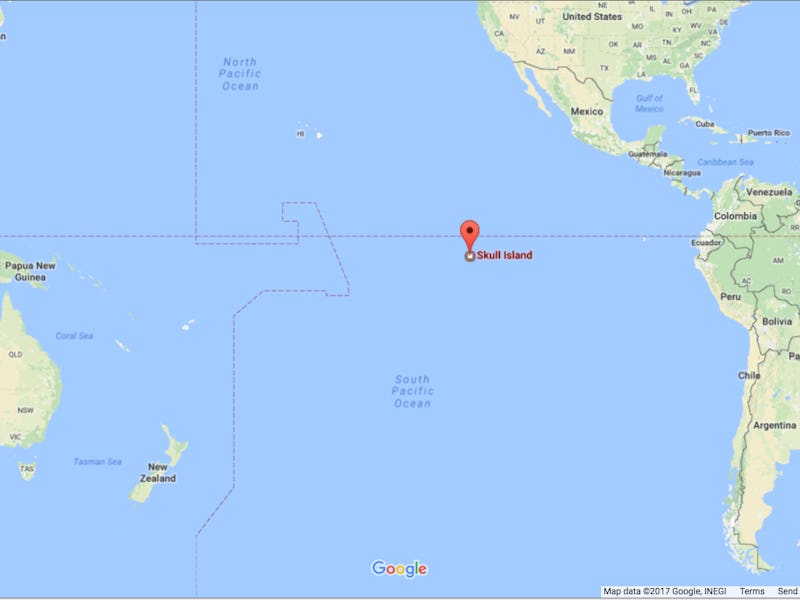Skull Island Can't Exist Where Google Says It Does
What are they trying to hide?

The year is 1973, and a ragtag group of U.S. military officials, scientists, and monster hunters set off on a special mission to map a newly discovered island with a very large secret. That’s the plot of Kong: Skull Island, the latest in the King Kong franchise, set to release on Friday.
Skull Island isn’t just Hollywood lore anymore, thanks to a fictional Google Map locator that places the C-shaped island squarely within the South Pacific. But there’s something more than a little suspicious about where Google says the island (fictionally) exists. Geologically speaking, an island at that location simply couldn’t be.
Check it out: Google places Skull Island just south of the equator, 3,000 miles west of the Pacific coast of South America. That plants the spot well within in the Pacific Plate — Earth’s largest tectonic plate — in an area of noted seismic and volcanic inactivity. How an island might crop up on such a stable and earthquake-free piece of seafloor is a mystery that neither Google nor Monarch (the fictional organization behind the discovery of the island) has answered.
Google Maps places Skull Island in a geologically quiet section of the Pacific Ocean.
Sure, it’s true that islands situated in the middle of oceanic tectonic plates are possible. Hawaii is a perfect example. Hawaii was formed by what are called hot spot volcanoes — an area of particularly hot mantle that boils up through the crust. But notice how Hawaii is not a single island but a linear chain? This is a result of the Pacific Plate migrating over the hot spot through tectonic movement over millions of years. As the plate moves to the northwest, new volcanoes form, resulting in the birth of islands. Old volcanoes become inactive, and over time those islands erode back into the sea.
Hawaii’s oldest islands, to the west of the chain, are about six million years old — the older ones have eroded to the point where they are completely under water, where they form a deep sea mountain chain that continues out towards Japan.
King Kong's location may remain a mystery.
This is important. Skull Island — if it exists — would have to be much, much older than that. The island supports non-bird descendants of the dinosaurs, including a very large cousin of the triceratops, which means the island must have existed 65 million years ago, and somehow been insulated from the asteroid impact that killed most of life on Earth.
Volcanic islands just don’t last that long — our planet is too geologically active. If Skull Island were the product of a hot spot volcano, it would either have to be very young, or it would have to exist as part of a chain of hot spot islands, much like Hawaii. There’s no evidence that either could be true.
Earth’s oldest island is Madagascar, which formed approximately 80-100 million years ago when it broke off from India as the supercontinent Gondwana ripped itself apart. It’s worth noting that this island is a broken off piece of continental shelf, not an accumulation of solidified lava.
The most damning evidence that we are being outright lied to about the whereabouts of Skull Island is this: Google and Monarch’s stories don’t match. The Google Map pin includes a link to discoverskullisland.com, a site run by Monarch that includes details on the islands strange beasts. That site includes coordinates to the location of Skull Island. Plot those on a map, and you get a location nowhere near the one that Google alleges. Instead, it’s a spot out in the Coral Sea, between the Solomon Islands and Australia.
This is a more plausible area for Skull Island to be found, in terms of both geology and plot coherency. Either way, someone is lying to you. The mysteries of King Kong’s kingdom won’t be easily uncovered — and you shouldn’t believe everything you read on the internet.